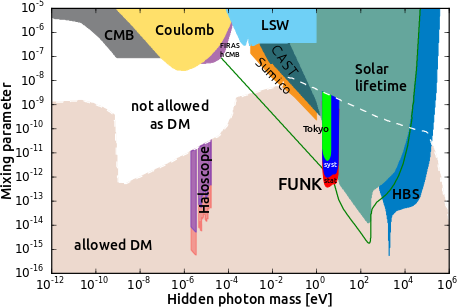Paper of the month: Search for hidden-photon dark matter with the FUNK experiment

January 11, 2018 by RebecaBV
Apart from this, we don’t know what other kinds of interactions DM should have; we only know that these must be weak, because otherwise we would have already detected these elusive particles.
One idea is that the dark sector is similar to the baryonic one and contains a “dark photon”, a photon-like particle, i.e., an additional U(1) gauge boson which mediates the force between dark sector particles. Unlike the photon, it could have a mass. Moreover, and this is the crucial point for experiments, the dark photon would eventually kinetically mix with the standard model photon, building a bridge between the two sectors.
The FUNK (Finding U(1)s of a Novel Kind) experiment searches for signals of this mixing between the dark and standard photons. It employs a portion of a spherical mirror with radius 3.4m and total surface area of 14.56m^2. Due to the mixing, the dark photon is accompanied by a small oscillating electric field. As the dark photon crosses the boundary of the mirror, this electric field will cause the electrons on the surface of the mirror to oscillate. These electrons will then emit ordinary photons with a wavelength corresponding to the mass of the dark photon. These photons can then be detected by a camera at the focal point of the mirror. The background is subtracted by measuring the photon rate when the camera is covered.
A preliminary analysis of FUNK measurements made from February 2017 finds no signal for hidden photon dark matter [1]. The red area in the plot below shows the exclusion area in DM parameter space bounded by statistical counting uncertainties, whilst the red area shows the same area bounded additionally by systematic uncertainties. These systematic uncertainties were investigated by moving the camera away from the focal point of the mirror. Future measurements and analysis of existing data are planned.

Figure 1: Extracted from [1]. Experimental limits on the possible mass and mixing of a hidden photon dark matter candidate.
Text by Andrea Caputo (University of Valencia) and Chloe Ransom (University of Zurich)
[1] Veberič, D., et al. "Search for hidden-photon dark matter with the FUNK experiment." arXiv preprint arXiv:1711.02958 (2017).


